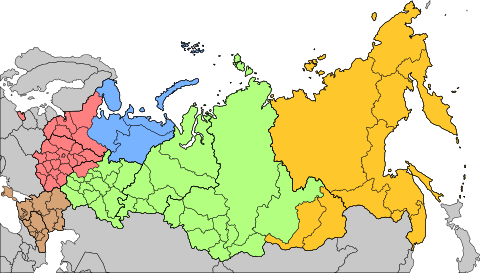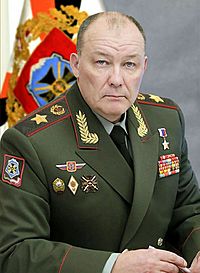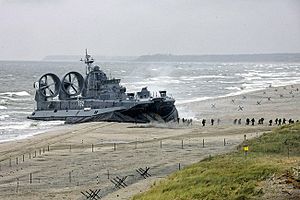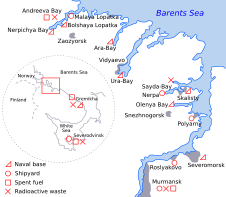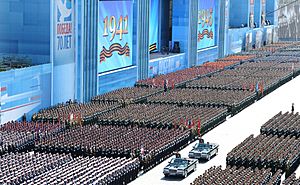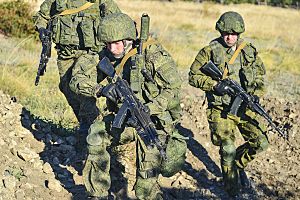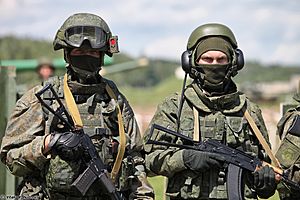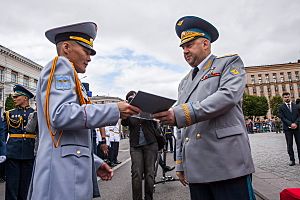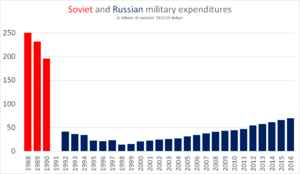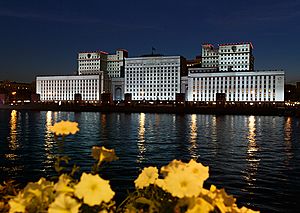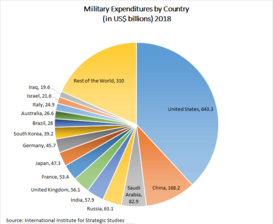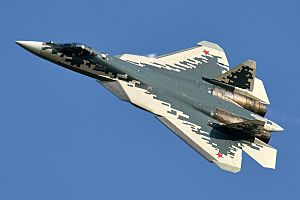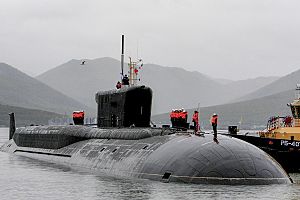Russian Armed Forces facts for kids
Quick facts for kids Armed Forces of the Russian FederationВооружённые си́лы Росси́йской Федера́ции |
|
|---|---|
| Medium emblem of the Armed Forces of the Russian Federation (27.01.1997-present).svg Emblem of the Russian Armed Forces |
|
| Established | 1721 (Imperial Russian Army) |
| Current form | 7 May 1992 |
| Parts | Airborne Forces |
| Headquarters | Ministry of Defence, Moscow |
| Leadership | |
| Supreme Commander-in-Chief | |
| Minister of Defence | |
| Serving soldiers | |
| Military age | 18 |
| Conscription | 12 months |
| Active employees/soldiers | c. 1,154,000 (ranked 5th) |
| Reserve personnel | c. 2,000,000 |
| Expenditures | |
| Budget | US$86,400,000,000 (2023) (ranked 3rd) |
| Percent of GDP | 4.1% (2023) |
| Industry | |
| Suppliers from inland |
See list:
Rostec
Rosatom United Aircraft Corporation United Shipbuilding Corporation Russian Helicopters Tactical Missiles Corporation Almaz-Antey High Precision Systems Moscow Institute of Thermal Technology Kalashnikov Concern Military Industrial Company Uralvagonzavod Kurganmashzavod KAMAZ |
| Suppliers from foreign countries |
|
| Annual imports | US$905,000,000 (2010–2021) |
| Annual exports | US$74,535,000,000 (2010–2021) |
| See also | |
| History | Military history of the Russian Federation |
| Ranks | Army ranks Navy ranks Aerospace Forces ranks |
|
Banner of the Armed Forces of the Russian Federation (obverse).svg |
|
The Armed Forces of the Russian Federation, also known as the Russian Armed Forces, are the military forces of Russia. They are one of the world's largest military groups. They have about 1.15 million active-duty soldiers and at least 2 million reserve personnel. Russia plans to grow its active force to 1.5 million by 2026. This would make it the third largest military in the world.
The Russian Armed Forces include the Ground Forces, the Navy, and the Aerospace Forces. There are also two special branches: the Strategic Rocket Forces and the Airborne Forces. In 2013, the Special Operations Forces Command was also created.
In 2023, Russia spent about $86.4 billion on its military. This made it the third-highest military spender globally. The Russian Armed Forces have the world's largest collection of nuclear weapons. They also have the second-largest fleet of ballistic missile submarines. Russia is one of only three countries that use strategic bombers. Most male citizens in Russia aged 18–27 must serve one year in the military.
Even with its military strength, Russia has faced challenges in its combat performance. Reports have noted problems with how the military is managed. During the 2022 Russian invasion of Ukraine, there were major issues with supplies. Different parts of the military struggled to work together. These problems have led to setbacks, including losing territory and equipment, and a high number of casualties.
The Russian Armed Forces are controlled by the Security Council of Russia. They are part of Russia's defense services. Other groups that help with defense include the Border Guard, the National Guard, and the Ministry of Emergency Situations.
Contents
Main Military Branches
The military forces under the Ministry of Defence are split into several parts:
- The three main "branches of Armed Forces": the Ground Forces, Aerospace Forces, and Navy.
- Two "separate troop branches": the Strategic Rocket Forces and Airborne Forces.
- The "special forces of Armed Forces": the Special Operations Forces.
- The Logistical Support, which helps with supplies and services.
There are also two other "separate troop branches" that are not under the main military command. These are the National Guard and the Border Service. The National Guard was formed from the former Internal Troops of Russia. It now reports directly to the President of Russia. The Border Service is part of the Federal Security Service, which is Russia's main internal intelligence agency. Both groups have important roles during wartime, along with their normal duties. They have their own land, air, and sea units.
The number of military personnel is decided by the President of Russia. In 2008, it was set at 2,019,629 people, with 1,134,800 being military personnel. In 2010, experts estimated about 1,027,000 active troops and 2,035,000 reserves. However, in 2013, the actual number of paid personnel was reported as 766,000.
Between 2005 and 2014, Russia's exports of major weapons grew by 37 percent. In 2015, Russia spent $66.4 billion on weapons, and $69.2 billion in 2016. This made it the third-highest spender after the U.S. and China. By 2021, the Russian Defence Ministry stated that 71.2% of the army and navy's weapons were modern.
History of the Russian Armed Forces
The Soviet Union officially ended on December 25, 1991. For about a year, there were attempts to keep its military united under the Commonwealth of Independent States (CIS). However, these attempts failed. Over time, military units in the new independent countries swore loyalty to their own governments. The military's assets were divided among these new states through various agreements.
The new Russian government took control of most of the former Soviet Internal Troops and KGB Border Troops. In March 1992, Russia announced it would create a National Guard. The plan was to form at least 11 brigades, each with 3,000 to 5,000 soldiers. The total number would not be more than 100,000. These National Guard units were to be placed in 10 regions, including Moscow. Many former Soviet Armed Forces members wanted to join the new Russian Army. However, President Yeltsin's plan for a "Russian Guard" was never fully put into action.
After signing the Belavezha Accords on December 21, 1991, the CIS countries agreed to appoint Marshal of Aviation Yevgeny Shaposhnikov as the temporary Minister of Defence and commander of their armed forces. This included nuclear forces. On February 14, 1992, Shaposhnikov officially became the Supreme Commander of the CIS Armed Forces. On March 16, 1992, Boris Yeltsin signed a decree creating the Armed Forces of the Russian Federation. He also took on the role of Supreme Commander. Finally, on May 7, 1992, Yeltsin signed the official decree establishing the armed forces.
In May 1992, General Colonel Pavel Grachev became the Minister of Defence. He was made Russia's first Army General when he took the job. By late 1993, the CIS military groups had become more about cooperation than actual command.
In the years that followed, Russian forces left central and eastern Europe. They also left some newly independent post-Soviet countries. Most of these withdrawals happened smoothly. However, Russian Armed Forces stayed in some disputed areas. These included the Sevastopol naval base in Crimea, as well as Abkhazia, South Ossetia, and Transnistria. The Armed Forces still have several bases in other countries, especially in former Soviet republics.
On February 24, 2022, Russian President Vladimir Putin ordered the Armed Forces to begin the 2022 Russian invasion of Ukraine. In July 2022, the Ground Forces started placing ammunition near civilian buildings. This was likely to protect them from Ukrainian attacks. Hours after a UN-brokered deal to restart Ukraine's grain exports, Russia bombed the Port of Odesa.
By the end of July 2022, Russia had sent 10 of its armies into the conflict. The Wagner Group, a private military group, became well-known. In June 2023, Putin wanted private military groups to sign contracts. This would put them under the Ministry of Defense's command. The leader of the Wagner Group, Yevgeny Prigozhin, was against this. Later in June, the Wagner Group turned against the Russian invasion of Ukraine and the Ministry of Defense. A peace deal was eventually reached.
Military Structure
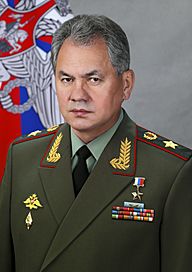
The Defence Ministry of the Russian Federation manages the Armed Forces. The General Staff has been the main commanding body since Soviet times. One expert said in 1998 that the General Staff is essential for the Ministry of Defence.
Other important departments include the Main Intelligence Directorate and the personnel department. There are also the Rear of the Armed Forces, Railway Troops, Signal Troops, and Construction Troops. The current Chief of the General Staff is General of the Army Valery Gerasimov.
Since December 1, 2012, the Ministry of Defence has included the Main Directorate of the Military Police. This group oversees all regional military police units.
In July 2018, the Main Military-Political Directorate of the Russian Armed Forces was created. This brought back a focus on training soldiers about military values, which had been stopped after the Soviet era.
The Russian military has three main services: the Russian Ground Forces, the Russian Navy, and the Russian Aerospace Forces. There are also two independent "arms of service": the Strategic Missile Troops and the Russian Airborne Troops. The Armed Forces are often simply called the Army, unless the Navy is specifically mentioned.
Military Districts
Since late 2010, the Ground Forces, Aerospace Forces, and Navy are organized into four military districts. These are the Western Military District, Southern Military District, Central Military District, and the Eastern Military District. These also act as four Joint Strategic Commands. Before 2010, there were six military districts.
Russia's four naval fleets and one flotilla were also organized similarly to the military districts. These seven older districts were combined into the four new ones. These new districts now include the aerospace and naval forces. There is one remaining Russian military base, the 102nd Military Base, in Armenia. It is part of the Southern Military District.
In 2014, the Northern Fleet was reorganized into its own Joint Strategic Command. Since January 1, 2021, this command has the status of a military district.
The five commands/districts are divided by geography:
- Joint Strategic Command West – Western Military District (headquarters in St. Petersburg), includes the Baltic Fleet.
- Joint Strategic Command North – Northern Military District (headquarters in Severomorsk), includes the Northern Fleet.
- Joint Strategic Command South – Southern Military District (headquarters in Rostov-on-Don) includes the Black Sea Fleet and Caspian Flotilla.
- Joint Strategic Command Center – Central Military District (headquarters in Yekaterinburg).
- Joint Strategic Command East – Eastern Military District (headquarters in Khabarovsk), includes the Pacific Fleet.
This new plan started on December 1, 2010. It is similar to an idea from a former Chief of the General Staff. In July 2011, a new Operational-Strategic Command for Missile-Space Defence was also created.
Russian security groups not controlled by the Ministry of Defence include the Internal Troops (now the National Guard of Russia's National Guard Forces Command), the Border Guard Service of Russia (part of the Federal Security Service), and the Ministry of Emergency Situations.
The Russian Navy has four main fleets and one smaller flotilla:
- Northern Fleet (headquarters at Severomorsk) – This forms its own Joint Strategic Command.
- Baltic Fleet (headquarters at Kaliningrad) – This is part of Joint Strategic Command West.
- Black Sea Fleet (headquarters at Sevastopol, a disputed region in Crimea) – This is part of Joint Strategic Command South.
- Pacific Fleet (headquarters at Vladivostok) – This is part of Joint Strategic Command East.
- Caspian Flotilla (headquarters at Astrakhan) – This is part of Joint Strategic Command South.
The Kaliningrad Special Region is under the Baltic Fleet Commander. It includes ground and coastal forces, as well as naval aviation. Both the Baltic Fleet and the forces in Kaliningrad report to Strategic Command West.
Similarly, the Northeast Group of Troops and Forces, based in Petropavlovsk-Kamchatskiy, includes all Russian Armed Forces in the Kamchatka Krai and Chukotka Autonomous Okrug. This group reports to the Commander of the Pacific Fleet.
Military Personnel
Conscription means that military service is required in Russia. The service term is 12 months. Men aged 18 to 27 are eligible. Some people can delay their service, such as students, men supporting disabled family members, or parents with at least two children. Men with a Ph.D. and close relatives of soldiers killed or disabled in service are excused from conscription.
There used to be widespread problems with hazing in the Army, known as dedovshchina. This is when older draftees would abuse newer ones. To fight this, a new rule was signed in March 2007. It cut the conscription term from 24 to 18 months. The term was cut further to one year on January 1, 2008.
By the end of 2005, 30% of Russian Armed Forces personnel were contract servicemen. The Armed Forces will continue to have a mix of contract soldiers and conscripts. The military needs to keep a reserve force ready to help if the main forces cannot handle a conflict alone.
As of March 2019, nearly 400,000 contractors serve in the Russian Army. Defence Minister Shoigu stated that in every regiment and brigade, two battalions are made up of contractors, while one is made up of recruits. Recruits are not sent on combat missions. As of late 2021, the number of contractors was twice the number of conscripts.
The Russian military also allows non-Russian citizens from the Commonwealth of Independent States to join. In 2010, a plan was made for foreigners without dual citizenship to sign up for five-year contracts. They could then become Russian citizens after three years of service. This change could help more people from CIS countries get Russian citizenship quickly. It also helps with army recruitment due to Russia's population challenges. Each soldier receives an Identity Card of the Russian Armed Forces. On September 20, 2022, a new law was passed. It allows foreign soldiers to get Russian citizenship after 12 months of service.
Awards for military service are covered in the Awards and Emblems of the Ministry of Defence of the Russian Federation.
In 2011, General Nikolai Makarov said Russia faced a shortage of fit men for conscription. This forced them to cut the number of conscripts by half. However, military draft dodging decreased by 66% since 2012. By March 2019, about 80% of young people drafted in autumn 2018 were found fit for service.
In March 2013, Defence Minister Sergey Shoygu promised that all army quarters would have showers by the end of the year. This was part of several improvements the Ministry of Defence announced. They also planned to replace old "footwraps" and traditional ear-flap hats with more modern gear. The Russian military's ushanka hats were improved between 2013 and 2015. New uniforms for hot climates were introduced in mid-2018.
On May 28, 2022, during the invasion of Ukraine, Vladimir Putin signed a law removing the upper age limit for signing a first contract for voluntary military service. Previously, this limit was 40 years old.
Military Education
The Russian military education system trains officers for specific military jobs. This is different from the American system. In Russia, students at civilian universities who want to join the reserve officer training program cannot choose their military job. Each civilian subject is linked to a specific military job.
The Russian military education system includes:
- Warrant officer schools: These train warrant officers for active duty.
- Higher military schools: These train officers for active duty as commanders of small groups (like platoons or companies).
- Military training centers at civilian universities: These train reserve officers for similar commanding roles.
- Military academies: These help officers improve their skills to become commanders of larger groups (like battalions or regiments).
- Military Academy of the General Staff of the Armed Forces of Russia: This trains top officers for strategic leadership roles.
- Adjunctura: This is like a graduate school for military officers. It allows them to earn an academic degree and become teachers in military schools.
Reserve Forces
Russian Armed Forces have reserves (Russian: запас) which include two parts:
- Active reserve: This is called the Mobilization Human Reserve.
- Inactive reserve: This is called the Mobilization Human Resource.
When military personnel finish their active duty, they are usually added to the Mobilization Human Resource. This applies to both conscripts and volunteers. People who graduate from civilian universities with military training are also added to this resource. Men who reach 27 years old and have not served in the military are also added.
Joining the Mobilization Human Reserve is voluntary. It means signing a special contract for three years. These reservists work part-time in military units. They are assigned to specific military jobs and take part in training and combat activities. Usually, reservists work 2–3 days per month and attend an annual training camp for 20 to 30 days.
The exact number of reservists is not publicly known. The military units staffed by reservists are also kept secret.
People in the Mobilization Human Resource (non-reservists) may be called for military training in peacetime. Each training can last up to 2 months. The total training time for a person cannot be more than 12 months. A person can only be called for training once every three years.
As of 2009, about 31 million citizens could be called for military service if there was a war.
Reservists are called up first during wartime. Non-reservists are called up second. The order for non-reservists depends on their age and military rank. For example, younger enlisted personnel are called before older ones.
Military Budget
Between 1991 and 1997, Russia's defense spending dropped significantly. In 1998, during a financial crisis, it was at its lowest point.
In the early 2000s, defense spending increased a lot each year. This led to the budget almost quadrupling in six years. According to the Finance Minister, this growth was planned to continue until 2010. The official military spending for 2005 was $32.4 billion. However, some sources believed the actual amount was much higher.
It is hard to estimate Russia's military spending accurately. Experts have noted that the official budget seems lower than what the size of the armed forces suggests. Some estimates suggest Russia's overall defense spending is now the second highest in the world, after the USA.
On September 16, 2008, Russian Prime Minister Vladimir Putin announced that the defense budget for 2009 would reach a record $50 billion.
In February 2009, due to the global financial crisis, the Russian Parliament's Defence Committee said the defense budget would be cut by 15%. This would bring it from $40 billion to $34 billion. However, in May 2009, First Deputy Prime Minister Sergei Ivanov said the budget for 2009 would be 1.3 trillion rubles (about $39.4 billion). A large part of this was for buying weapons.
According to Vladimir Komoyedov, head of the State Duma's Defence Committee, Russia planned to spend 101.15 billion rubles on nuclear weapons from 2013 to 2015. In November 2013, President Putin said the country's defense budget would reach 2.3 trillion rubles. This was a huge increase from the 2003 budget of 600 billion rubles.
The Russian government's official military budget for 2014 was about 2.49 trillion rubles (around $69.3 billion). This made it the fourth largest in the world. The budget was set to rise to 3.03 trillion rubles in 2015 and 3.36 trillion rubles in 2016. As of 2014, Russia's military budget was higher than any other European nation.
In 2015, experts found that Russia was the world's second-biggest exporter of major weapons from 2010–2014. Its exports increased by 37%. India, China, and Algeria bought almost 60% of Russia's total exports.
In 2017, Russia reportedly cut its defense spending by 20%. This was because Vladimir Putin wanted to spend money on other areas like healthcare and education. This cut lowered Russia's military spending to $66.3 billion. Russia then became the fourth-highest military spender. Russia's defense budget was $48 billion in 2019 and $61.7 billion in 2020.
However, due to the Russian invasion of Ukraine in February 2022, the Russian government greatly increased military spending to over $85 billion. This brought Russia back to the third position as the highest military spender. The increased spending was needed to replace losses from the war and shift Russia's economy towards supporting the military.
Weapon Procurement
About 70% of the former Soviet Union's defense industries are in Russia. Many defense companies have been made private. Some have formed important partnerships with companies in other countries.
The recent steps to make the Armed Forces more modern have been possible because Russia's economy has improved. This is due to its oil and gas revenues and a stronger internal market. Currently, the military is undergoing a major equipment upgrade. The government plans to spend about $200 billion (equal to about $400 billion in purchasing power) on developing and producing military equipment between 2006 and 2015. This is part of the State Armament Programme for 2007–2015.
After lessons learned from the Russo-Georgian War, the State Armament Programme for 2011–2020 was launched in December 2010. Prime Minister Putin announced that over $650 billion would be spent on new equipment in the next 10 years. The goal is to have 30% modern equipment in the army, navy, and air force by 2015, and 70% by 2020. In some areas, the amount of new weapons will reach 80% or even 100%.
The Russian Ministry of Defence plans to buy many new items. These include up to 250 intercontinental ballistic missiles, 800 aircraft, 1,200 helicopters, 44 submarines, 36 frigates, 28 corvettes, 18 cruisers, 24 destroyers, 6 aircraft carriers, and 62 air defense battalions. Several existing types of equipment will also be updated.
From 2012 to 2017, the Armed Forces received over 30,000 new and updated weapons and equipment. This included more than 50 warships, 1,300 aircraft, over 1,800 drones, and 4,700 tanks and armored vehicles. In comparison, from 2007–2011, they received only two warships, 151 aircraft, and 217 tanks. The Russian army also gets 150–250 aircraft and over 300 short-range drones each year.
In 2011, Russia's chief military prosecutor said that 20% of the defense budget was being stolen or misused each year. It is thought that this lack of funds might lead to equipment not being properly maintained. This could have caused some equipment failures seen during the 2022 invasion of Ukraine.
In 2018, the Russian Armed Forces adopted 35 new types of weapons and military equipment. They also finished testing 21 more. The Ministry of Defence bought the YeSU TZ battlefield management system that same year. This system helps control artillery, electronic warfare, ground vehicles, air defense, and logistics.
Since 2012 and as of March 2019, many military units have received new weapons. Twelve missile regiments got Yars ICBMs. Ten missile brigades received Iskander tactical missile systems. Thirteen aviation regiments got MiG-31BM, Su-35S, Su-30SM, and Su-34 combat aircraft. Three army aviation brigades and six helicopter regiments received Mi-28N and Ka-52 combat helicopters. Twenty surface-to-air missile regiments got S-400 Triumf systems. Twenty-three batteries received Pantsir-S anti-aircraft systems. Seventeen batteries got Bal and Bastion mobile coastal defense missile systems.
From 2012 to April 2021, the Ground Forces received over 15,500 pieces of weapon systems and equipment. All missile brigades now have the Iskander system. The Aerospace Force and naval aviation received over 1,500 aircraft and helicopters. The Navy received more than 190 ships, vessels, and boats.
From 2012 to December 2020, the number of long-range land, sea, and air-launched cruise missiles increased by 37 times. The number of vehicles that carry these missiles also increased by 13 times.
In late 2022, Russian Defense Minister Sergey Shoigu stated that supplies of major weapons had increased by 30% that year. The amount of ammunition for rockets, artillery, and aircraft systems increased by 69% to 109%. The Chief of Russian Armed Forces General Staff Valery Gerasimov also said his troops received over 3,100 armored, rocket-artillery, and other weapons.
In early 2023, reports said the Russian Defense Ministry bought over a thousand tablets with Russian software for high-ranking officials. They also started receiving new gliding bombs that can travel tens of kilometers.
Sergey Shoigu claimed in May 2023 that the number of main weapons bought increased by 170% compared to early 2022. For "especially needed weapons," the increase was seven times.
As of May 2023, Russia reportedly started making FPV (First Person View) drones. They used these drones in Ukraine for scouting and as attack tools.
In June 2023, Deputy Secretary of the Russian Federation Security Council Dmitry Medvedev claimed Russia had produced 600 tanks since the start of the year. President Vladimir Putin also stated that Russia had increased military production 2.7 times over a year. In the most important areas, production increased 10 times.
Nuclear Weapons
As of January 2017, experts estimated that Russia has about 1,765 active strategic nuclear warheads. It also has another 2,700 strategic and tactical warheads that are not active or are waiting to be taken apart. Russia's Strategic Rocket Forces control its land-based nuclear warheads. The Navy controls submarine-based missiles, and the Aerospace Forces control air-launched warheads. Russia's nuclear warheads are located in four types of places:
- Land-based fixed sites (silos), like the R-36 missile.
- Land-based mobile units, like the RT-2PM2 Topol-M and new RS-24 Yars missiles.
- Submarine-based missiles, like the R-29RMU2 Layner and RSM-56 Bulava missiles.
- Air-launched warheads from the Russian Aerospace Forces' Long Range Aviation Command.
Russia's military rules see NATO expansion as a threat. They reserve the right to use nuclear weapons if a normal attack threatens the country's existence. Because of this, Russia's nuclear forces received enough money in the late 1990s. The number of intercontinental ballistic missiles and warheads has gone down over the years. This is partly due to arms agreements with the U.S. and partly due to not enough money for maintenance. However, new missiles are being deployed to counter missile defense systems.
Russia has developed new RT-2PM2 Topol-M (SS-27) missiles. A Russian general claimed these missiles can get past any missile defense system. The missile can change its path in both air and space to avoid being stopped. It is designed to be launched from mobile units on land.
Because of global concern that Russian nuclear technology might fall into the wrong hands, the federal government of the United States and many other countries gave a lot of money to Russia's nuclear forces in the early 1990s. This money helped to take warheads out of service under international agreements. It also helped improve security and training at Russian nuclear sites.
In September 2007, the "Father of All Bombs" (a powerful fuel-air explosive) was successfully tested.
Images for kids
-
Russian stamp honoring a soldier killed in the Russo-Ukrainian War.
-
Russian stamp honoring a soldier killed in the Russo-Ukrainian War.
See also
 In Spanish: Fuerzas Armadas de Rusia para niños
In Spanish: Fuerzas Armadas de Rusia para niños
- Military academies in Russia
- Military commissioning schools in Russia
- Reserve Officer Training in Russia
- Warrant officer schools of the Russian Armed Forces
- Adjunctura in Russia
- Awards and emblems of the Ministry of Defence of the Russian Federation
- Uniforms of the Russian Armed Forces
- Military Band Service of the Armed Forces of Russia
- History of Russian military ranks
- Army ranks and insignia of the Russian Federation
- Naval ranks and insignia of the Russian Federation



